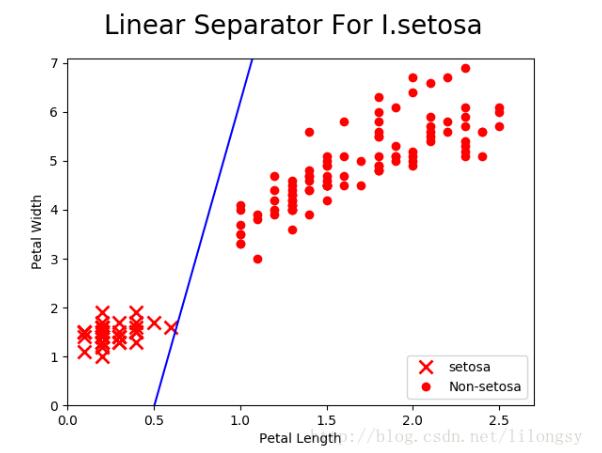本文实例为大家分享了TensorFlow实现创建分类器的具体代码,供大家参考,具体内容如下
创建一个iris数据集的分类器。
加载样本数据集,实现一个简单的二值分类器来预测一朵花是否为山鸢尾。iris数据集有三类花,但这里仅预测是否是山鸢尾。导入iris数据集和工具库,相应地对原数据集进行转换。
|
1
2
3
4
5
6
7
8
9
10
11
12
13
14
15
16
17
18
19
20
21
22
23
24
25
26
27
28
29
30
31
32
33
34
35
36
37
38
39
40
41
42
43
44
45
46
47
48
49
50
51
52
53
54
55
56
57
58
59
60
61
62
63
64
65
66
67
68
69
70
71
72
73
74
75
76
77
78
79
80
81
82
83
84
85
86
87
88
89
90
91
92
93
94
95
96
97
98
99
100
101
102
103
104
105
106
107
|
# Combining Everything Together#----------------------------------# This file will perform binary classification on the# iris dataset. We will only predict if a flower is# I.setosa or not.## We will create a simple binary classifier by creating a line# and running everything through a sigmoid to get a binary predictor.# The two features we will use are pedal length and pedal width.## We will use batch training, but this can be easily# adapted to stochastic training.import matplotlib.pyplot as pltimport numpy as npfrom sklearn import datasetsimport tensorflow as tffrom tensorflow.python.framework import opsops.reset_default_graph()# 导入iris数据集# 根据目标数据是否为山鸢尾将其转换成1或者0。# 由于iris数据集将山鸢尾标记为0,我们将其从0置为1,同时把其他物种标记为0。# 本次训练只使用两种特征:花瓣长度和花瓣宽度,这两个特征在x-value的第三列和第四列# iris.target = {0, 1, 2}, where '0' is setosa# iris.data ~ [sepal.width, sepal.length, pedal.width, pedal.length]iris = datasets.load_iris()binary_target = np.array([1. if x==0 else 0. for x in iris.target])iris_2d = np.array([[x[2], x[3]] for x in iris.data])# 声明批量训练大小batch_size = 20# 初始化计算图sess = tf.Session()# 声明数据占位符x1_data = tf.placeholder(shape=[None, 1], dtype=tf.float32)x2_data = tf.placeholder(shape=[None, 1], dtype=tf.float32)y_target = tf.placeholder(shape=[None, 1], dtype=tf.float32)# 声明模型变量# Create variables A and b (0 = x1 - A*x2 + b)A = tf.Variable(tf.random_normal(shape=[1, 1]))b = tf.Variable(tf.random_normal(shape=[1, 1]))# 定义线性模型:# 如果找到的数据点在直线以上,则将数据点代入x2-x1*A-b计算出的结果大于0;# 同理找到的数据点在直线以下,则将数据点代入x2-x1*A-b计算出的结果小于0。# x1 - A*x2 + bmy_mult = tf.matmul(x2_data, A)my_add = tf.add(my_mult, b)my_output = tf.subtract(x1_data, my_add)# 增加TensorFlow的sigmoid交叉熵损失函数(cross entropy)xentropy = tf.nn.sigmoid_cross_entropy_with_logits(logits=my_output, labels=y_target)# 声明优化器方法my_opt = tf.train.GradientDescentOptimizer(0.05)train_step = my_opt.minimize(xentropy)# 创建一个变量初始化操作init = tf.global_variables_initializer()sess.run(init)# 运行迭代1000次for i in range(1000): rand_index = np.random.choice(len(iris_2d), size=batch_size) # rand_x = np.transpose([iris_2d[rand_index]]) # 传入三种数据:花瓣长度、花瓣宽度和目标变量 rand_x = iris_2d[rand_index] rand_x1 = np.array([[x[0]] for x in rand_x]) rand_x2 = np.array([[x[1]] for x in rand_x]) #rand_y = np.transpose([binary_target[rand_index]]) rand_y = np.array([[y] for y in binary_target[rand_index]]) sess.run(train_step, feed_dict={x1_data: rand_x1, x2_data: rand_x2, y_target: rand_y}) if (i+1)%200==0: print('Step #' + str(i+1) + ' A = ' + str(sess.run(A)) + ', b = ' + str(sess.run(b)))# 绘图# 获取斜率/截距# Pull out slope/intercept[[slope]] = sess.run(A)[[intercept]] = sess.run(b)# 创建拟合线x = np.linspace(0, 3, num=50)ablineValues = []for i in x: ablineValues.append(slope*i+intercept)# 绘制拟合曲线setosa_x = [a[1] for i,a in enumerate(iris_2d) if binary_target[i]==1]setosa_y = [a[0] for i,a in enumerate(iris_2d) if binary_target[i]==1]non_setosa_x = [a[1] for i,a in enumerate(iris_2d) if binary_target[i]==0]non_setosa_y = [a[0] for i,a in enumerate(iris_2d) if binary_target[i]==0]plt.plot(setosa_x, setosa_y, 'rx', ms=10, mew=2, label='setosa')plt.plot(non_setosa_x, non_setosa_y, 'ro', label='Non-setosa')plt.plot(x, ablineValues, 'b-')plt.xlim([0.0, 2.7])plt.ylim([0.0, 7.1])plt.suptitle('Linear Separator For I.setosa', fontsize=20)plt.xlabel('Petal Length')plt.ylabel('Petal Width')plt.legend(loc='lower right')plt.show() |
输出:
|
1
2
3
4
5
|
Step #200 A = [[ 8.70572948]], b = [[-3.46638322]]Step #400 A = [[ 10.21302414]], b = [[-4.720438]]Step #600 A = [[ 11.11844635]], b = [[-5.53361702]]Step #800 A = [[ 11.86427212]], b = [[-6.0110755]]Step #1000 A = [[ 12.49524498]], b = [[-6.29990339]] |

以上就是本文的全部内容,希望对大家的学习有所帮助,也希望大家多多支持服务器之家。
原文链接:http://blog.csdn.net/lilongsy/article/details/79261129










